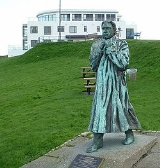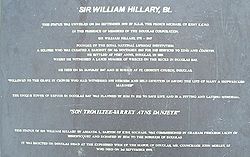
William Hillary
Encyclopedia

England
England is a country that is part of the United Kingdom. It shares land borders with Scotland to the north and Wales to the west; the Irish Sea is to the north west, the Celtic Sea to the south west, with the North Sea to the east and the English Channel to the south separating it from continental...
soldier, author and philanthropist
Philanthropist
A philanthropist is someone who engages in philanthropy; that is, someone who donates his or her time, money, and/or reputation to charitable causes...
, best known as the founder of the Royal National Lifeboat Institution
Royal National Lifeboat Institution
The Royal National Lifeboat Institution is a charity that saves lives at sea around the coasts of Great Britain, Ireland, the Channel Islands and the Isle of Man, as well as on selected inland waterways....
in 1824.
A Yorkshire
Yorkshire
Yorkshire is a historic county of northern England and the largest in the United Kingdom. Because of its great size in comparison to other English counties, functions have been increasingly undertaken over time by its subdivisions, which have also been subject to periodic reform...
Quaker by descent, the son of Richard Hillary and his wife, Hannah Wynne .
He spent two years, as an Equerry
Equerry
An equerry , and related to the French word "écuyer" ) is an officer of honour. Historically, it was a senior attendant with responsibilities for the horses of a person of rank. In contemporary use, it is a personal attendant, usually upon a Sovereign, a member of a Royal Family, or a national...
to Prince Augustus Frederick
Prince Augustus Frederick, Duke of Sussex
The Prince Augustus Frederick, Duke of Sussex , was the sixth son of George III of the United Kingdom and his consort, Charlotte of Mecklenburg-Strelitz. He was the only surviving son of George III who did not pursue an army or naval career.- Early life :His Royal Highness The Prince Augustus...
, the young son of George III, his duties included sailing with the prince in the Mediterranean, where William Hillary learned his basic seamanship and navigation skills
Hillary married Essex
Essex
Essex is a ceremonial and non-metropolitan county in the East region of England, and one of the home counties. It is located to the northeast of Greater London. It borders with Cambridgeshire and Suffolk to the north, Hertfordshire to the west, Kent to the South and London to the south west...
-born heiress Frances Elizabeth Disney Ffytche (or Fytche) on 21 February 1800. In the same year, their twins were born, a son, Augustus William Hillary (d. 30 December 1855)) and a daughter, Elizabeth Mary.
However, Hillary's religious background did not meet with the approval of his wife's father, but Hillary still spent his wife’s inheritance (some £20,000) on creating England’s largest private army, put at the service of King George III
George III of the United Kingdom
George III was King of Great Britain and King of Ireland from 25 October 1760 until the union of these two countries on 1 January 1801, after which he was King of the United Kingdom of Great Britain and Ireland until his death...
against Napoleon’s threatened invasion. It was for this that he reputedly received his Baronet
Baronet
A baronet or the rare female equivalent, a baronetess , is the holder of a hereditary baronetcy awarded by the British Crown...
cy in 1805.
By some accounts, Hillary settled in the Isle of Man
Isle of Man
The Isle of Man , otherwise known simply as Mann , is a self-governing British Crown Dependency, located in the Irish Sea between the islands of Great Britain and Ireland, within the British Isles. The head of state is Queen Elizabeth II, who holds the title of Lord of Mann. The Lord of Mann is...
in 1808 in order to put a few miles and a little water between himself and his creditors, and to bury quietly the murkier details surrounding his elopement and marriage. In 1813, he re-married (after presumably divorcing his first wife, as she did not die until 1828), this time to a local Manx woman, Emma Tobin.
Living at Fort Anne, Douglas, Isle of Man
Douglas, Isle of Man
right|thumb|250px|Douglas Promenade, which runs nearly the entire length of beachfront in Douglasright|thumb|250px|Sea terminal in DouglasDouglas is the capital and largest town of the Isle of Man, with a population of 26,218 people . It is located at the mouth of the River Douglas, and a sweeping...
, Hillary soon became aware of the treacherous nature of the Irish Sea
Irish Sea
The Irish Sea separates the islands of Ireland and Great Britain. It is connected to the Celtic Sea in the south by St George's Channel, and to the Atlantic Ocean in the north by the North Channel. Anglesey is the largest island within the Irish Sea, followed by the Isle of Man...
, with many ships being wrecked around the Manx coast. He drew up plans for a lifeboat service manned by trained crews, intended not only for the Isle of Man, but for all of the British
Great Britain
Great Britain or Britain is an island situated to the northwest of Continental Europe. It is the ninth largest island in the world, and the largest European island, as well as the largest of the British Isles...
coast. In February 1823 he published a pamphlet entitled An Appeal To The British Navy On The Humanity And Policy Of Forming A National Institution For The Preservation Of Lives And Property From Shipwreck.
Initially he received little response from the Admiralty
Admiralty
The Admiralty was formerly the authority in the Kingdom of England, and later in the United Kingdom, responsible for the command of the Royal Navy...
but on appealing to the more philanthropic members of London society, including Thomas Wilson (MP for Southwark
Southwark
Southwark is a district of south London, England, and the administrative headquarters of the London Borough of Southwark. Situated east of Charing Cross, it forms one of the oldest parts of London and fronts the River Thames to the north...
) and George Hibbert
George Hibbert
George Hibbert was an eminent English merchant, politician, slave- and ship-owner, amateur botanist and book collector. With Robert Milligan, he was also one of the principals of the West India Dock Company which instigated the construction of the West India Docks on London's Isle of Dogs in 1800...
, chairman of the West Indies Merchants, the plans were enthusiastically adopted and the National Institution for the Preservation of Life from Shipwreck was founded on 4 March 1824 at a meeting in The Tavern, Bishopsgate Street, London
London
London is the capital city of :England and the :United Kingdom, the largest metropolitan area in the United Kingdom, and the largest urban zone in the European Union by most measures. Located on the River Thames, London has been a major settlement for two millennia, its history going back to its...
.
The title changed 30 years later to the Royal National Lifeboat Institution and the first of the new lifeboats to be built was stationed at Douglas in recognition of Hillary's work.
At the age of 60, Hillary took part in the rescue, in 1830, of the packet St George, which had foundered on Conister Rock at the entrance to Douglas harbour. He commanded the lifeboat, was washed overboard with others of the lifeboat crew, yet finally everyone aboard the St George was rescued with no loss of life. This incident prompted Hillary to set up a scheme to build the Tower of Refuge
St Mary's Isle (Conister Rocks or Tower of Refuge)
St Mary's Isle is a partially submerged reef within Douglas Bay on the Isle of Man....
on Conister Rock. The structure, designed by architect
Architect
An architect is a person trained in the planning, design and oversight of the construction of buildings. To practice architecture means to offer or render services in connection with the design and construction of a building, or group of buildings and the space within the site surrounding the...
John Welch
John Welch
John Welch was a U.S. Representative from Ohio.-Biography:Born near New Athens, Ohio, Welch received a liberal schooling and was graduated from Franklin College....
was completed in 1832 and still stands at the entrance to Douglas harbour (it is the subject of a poem by William Wordsworth
William Wordsworth
William Wordsworth was a major English Romantic poet who, with Samuel Taylor Coleridge, helped to launch the Romantic Age in English literature with the 1798 joint publication Lyrical Ballads....
).
In Memorial
There are three memorials to Sir William Hillary in Douglas, Isle of Man:- Sunken Gardens, Loch Promenade, with the following inscription:

Sir William Hillary & his volunteer crew go to the aid of the stricken St. George 20th November 1830
- St George's Church, with the following inscription:
TO THE HONOURED MEMORY OF/LIEUT. COLONEL SIR WILLIAM HILLARY, BT./OF YORKSHIRE, ESSEX AND THE ISLE OF MAN/ LIEUTENANT TURCOPOLIER OF THE ORDER OF THE KNIGHTS OF ST JOHN OF JERUSALEM./BORN 1771. DIED 1847/SOLDIER, AUTHOR, PHILANTHROPIST./HE FOUNDED IN THE YEAR 1824 THE ROYAL NAVAL LIFE BOAT INSTITUTION/AND IN 1832 BUILT THE TOWER OF REFUGE IN DOUGLAS BAY./FEARLESS HIMSELF IN THE WORK OF RESCUE FROM SHIPWRECK HE HELPED SAVE 509 LIVES/AND WAS THREE TIMES AWARDED THE GOLD MEDAL OF THE INSTITUTION FOR GREAT GALLANTRY./WHAT HIS WISDOM PLANNED AND POWER ENFORCED/MORE POTENT STILL HIS GREAT EXAMPLE SHOWED.
- Douglas HeadDouglas HeadDouglas Head is a rocky point on the Isle of Man overlooking Douglas Bay and harbour. Views extend to include Snaefell Mountain and Laxey-General:...
, with the following inscription:

Sir William Hillary, Bt.
This statue was unveiled on 21 September 1999 by H.R.H Prince Michael of Kent K.C.V.O.
In the presence of Members of the Douglas Corporation.
Sir William Hillary 1771-1847
Founder of the Royal National Lifeboat Institution.
A soldier who was created a Baronet on 8 November 1805 for his services to king and country.
He settled at Fort Anne, Douglas in 1806 where he witnessed a large number of wrecks on the rocks in Douglas Bay.
He died on 5 January 1847 and is buried at St. George's Church, Douglas.
"Followed to the grave by crowds who had witnessed his heroism and self-devotion in saving the life of many a shipwrecked mariner".
The Unique Tower of Refuge in Douglas Bay was planned by him in 1832 to save life and is a fitting and lasting memorial.
"SON TROAILTEE-VARREY AYNS DANJEYR"
This statue of Sir William Hillary by Amanda L. Barton of Kirk Michael was commissioned by Graham Ferguson Lacey of Bishopscourt and donated by him to the Borough of Douglas.
It was erected on Douglas Head at the expressed wish of the Mayor of Douglas, Mr Councillor John Morley, J.P. who died on 3 September 1999.

